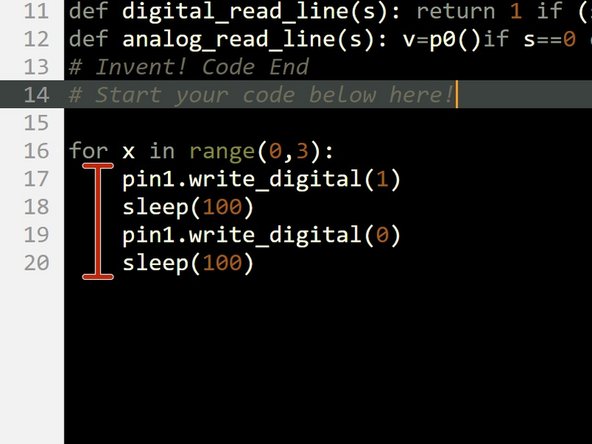Introduction
What if our robot gets in trouble half way across the planet? Let's make a program so it can transmit S.O.S in Morse Code to let us know if its in trouble!
-
-
Having red/green LEDs is a great start to communicating with our robot
-
What if we want to communicate more than just red or green?
-
Morse Code allows us to send any letter or number we like, just using a single light or buzzer!
-
Watch the video to find out more.
-
-
-
Let's write a program that will send the letter S.
-
In the picture is a program to send 1 dot with the red LED. For your sleep() lines, we suggest:
-
100 milliseconds for a dot
-
1000 milliseconds for a dash
-
Extend the program in the picture to send 3 dots, which is an S - your red LED module should still be plugged in to P1 like the last lesson!
-
-
-
Good programs always try not to repeat code that does the same thing, so the program is as small and efficient as possible.
-
We could put the code for one dot in a while True: loop, but this would just do dots forever - not what we want!
-
We are going to use a for loop to repeat something a set number of times.
-
-
-
A for loop needs 3 things:
-
An iterable - this is something that Python uses to count how many times the loop has run. It can be called anything you like - we have called it x in this example.
-
A range to iterate over - a range in Python just creates a list of numbers, starting from the first one (0 in this case) and up to, but not including, the last one (3). So our range is 0,1,2.
-
Some code to run each time - this is just like the while loop from before and can be as long or as complicated as you like!
-
So this for loop starts with x=0. After the first loop run, x is increased to 1. After the second it is increased to 2, the code then runs a final time and the loop will finish. So this loop will run 3 times.
-
Don't forget - just like a while loop, we need the colon (:) after the iterable and range, and any code you want to run in the loop needs to be indented.
-
-
-
Put your code to send a dot with the red LED inside the for loop, so your robot sends an 's' with much less code.
-
Try changing the range, and see how it affects how many dots get sent!
-
-
-
Let's talk a bit more about indentation - we have already been doing it inside the for and while loops.
-
Indentation is very important in programming - it makes it easy for others to read your code, and for you to read it later!
-
You can indent a line by pressing the TAB key.
-
In most languages, indentation is optional and only serves to make the code easier to read - however, in Python it is not optional!
-
Python uses indentation to define which lines of code are inside other things - for example which lines of code should be repeated in a loop. See how all of the lines inside the for loop are indented the same?
-
You should always make sure Python code is indented correctly - things won't work properly otherwise.
-
-
-
You might have noticed when you were listening to the code, that between the letters we need longer gaps so you can tell when they start and finish.
-
A time of 2 seconds works well.
-
Put your for loop that flashes an S inside a while True: loop, so it flashes S forever, and add a wait block so there is a gap of seconds between each S.
-
Make sure it is indented properly - the first line of the for loop should be indented once as it is inside the while loop, and the code inside the for loop should be indented twice - it is inside the while loop and the for loop!
-
-
-
Let's make a program to get our robot to flash SOS using an LED, in case it has a problem.
-
Your program should flash the sequence of dots and dashes required for the letters SOS - for bonus points put it in a while loop to make it flash SOS forever!
-
Try to shorten your program using for loops - you will need 3 separate loops, or 2 if you're really clever!
-
-
-
Using lights for Morse Code is great for long distances, such as between two ships, but what if you are looking the other way when your robot is in trouble?
-
Replace your LED module with the buzzer module like in the picture, so your robot buzzes SOS instead.
-
If you're feeling really clever, put the LED module back into another output and add some more code so it flashes and buzzes the sequence for S.O.S!
-











